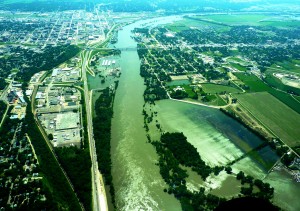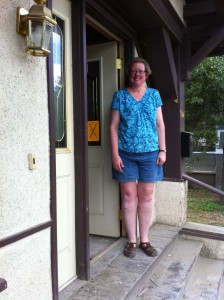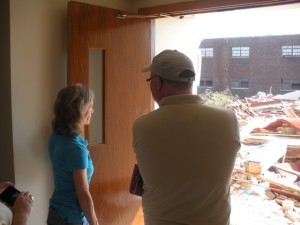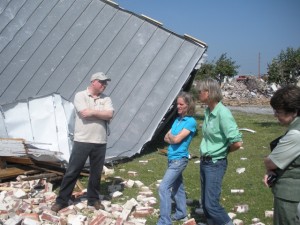Dear sisters and brothers,
The annual conference of the National Voluntary Organizations Active in Disaster (National VOAD) is taking place this week in Kansas City, bringing together the leaders of nearly every faith-based, secular, and governmental disaster response organization. The conference is a wonderful chance to network with colleagues and learn about the emerging trends in the sector. This last Sunday evening, the deadliest tornado in recorded U.S. history devastated the city of Joplin, Missouri, just three hours south of where the conference would begin the following day.
Needless to say, the dynamic at the conference has been very different this year. Those representing early response organizations – groups like the American Red Cross and Southern Baptist Disaster Relief – re-routed staff to Joplin almost immediately, while those of us who remained at the conference were itching to join them. But all of us have been united in the knowledge that, very soon, it will be time to get to work.
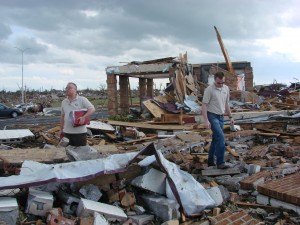
Director Kevin Massey and Associate Director Mike Nevergall stand among what is left of Peace Lutheran Church
Yesterday, I went to Joplin, along with my colleagues Kevin Massey and Maria Maldonado, at the invitation of Bishop Jerry Mansholt of the ELCA Central States Synod. We traveled with Pastor Bill Pape, who has been serving as interim pastor at Peace Lutheran Church in Joplin for the last few years. The tornado completely destroyed the church building at Peace Lutheran, but thankfully, all of the members are now accounted for.
We have all seen the images of Joplin on television, with destruction stretching as far as you can see, but there are simply no words sufficient to describe seeing it in person. The thing that always stuns me with tornadoes is the way they cut a swath of damage but leave surrounding areas mostly untouched. Driving south on Range Line Road, which runs on the east side of the city, there was not much sign of tornado damage at first. But then we crested a small hill, the disaster area spread out in front of us, and I instantly felt tears well up in my eyes. Homes leveled to the foundations, cars flipped over as if they were toys, businesses flattened, trees stripped of all leaves and branches. Block after block after block, there are buildings which will need to be simply demolished and started over again. For a concentrated area, it may be the worst devastation I have seen in my more than five years with Lutheran Disaster Response.
After a disaster has happened, we receive requests from congregations who want to send supplies into the area. We also receive requests from
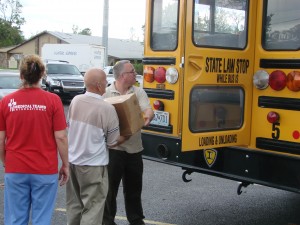
Pastor Bill Pape and Kevin Massey help unload items being collected at a Lutheran elementary school.
volunteers who want to travel to the area to serve, in whatever way they can be helpful. The early stages of a disaster response can be complicated, as a community figures out how to plan its recovery, and these sorts of well-intentioned offers can sometimes be more of a hindrance than a help. But today, just three days after the event, we met a couple from Dallas who had driven to Joplin and set up a trailer from which they were distributing grilled hamburgers and hot dogs to anyone who wanted one. We also helped unload donated goods at a Lutheran elementary school that was receiving things to distribute from neighboring towns. In this moment, those offers of help were meaningful and appreciated.
At the end of our day in Joplin, we sat with members of Peace Lutheran to talk about next steps for their congregation. Bishop Mansholt read to us from Psalm 46, and then we heard members of the congregation share their stories about the last few days. We laughed together, which felt good for the soul in the midst of such a difficult situation, but there were also many tears. The members of Peace Lutheran are determined to worship together this Sunday, and they hope to do so in the parking lot next to where their church stood less than a week ago. And they want you to know how important it has been to know that people are praying for them, thinking about them, and asking how to help them, from across the country and around the world.

Bishop Jerry Mansholt meets with gathered members of Peace Lutheran Church
I ask you to continue praying for the people of Joplin, and specifically for Pastor Pape and the members of Peace Lutheran. Our strength as Lutherans is being there for the long haul, understanding that disaster recovery is a long-distance run and not a sprint. The people of Joplin will need our ongoing support for months and even years to come. I hope you will consider a gift to the “U.S. Severe Spring Storms” account, from which we have begun and will continue a meaningful response to this disaster.
Finally, I would like to ask your prayers for me personally and for my disaster response colleagues, Lutheran and otherwise. This spring has been a steady stream of new disasters, and with hurricane season less than a week away, it feels a bit overwhelming at times. It is in difficult times like these that I am uplifted by your ongoing support for this important ministry we do together!
In service,
Mike Nevergall
Associate Program Director

